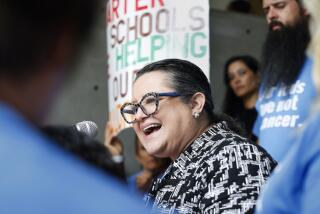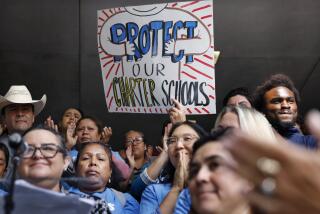L.A.’s is among districts exempt from No Child Left Behind rules
The Los Angeles Unified School District, and seven others in California, will have more freedom to spend millions of federal dollars, create new ways to evaluate teachers and schools and replace restrictive testing and other rules, under a groundbreaking agreement announced Tuesday.
The eight school systems are the first in the country to win such rights based on a direct appeal to the U.S. Department of Education. Previously, the department would consider exemptions to the No Child Left Behind law only if state governments applied.
One result is that these districts will operate under different rules than other California school systems, which prompted sharp criticism in some quarters. These districts, which represent more than 1 million students, joined together to seek waivers to the law because top state education officials opposed the federal process.
No Child Left Behind, enacted under President George W. Bush, was aimed at ensuring that nearly all students would be academically successful by 2014. It forced states to pay more attention to student achievement, especially as measured by standardized tests. But opponents say it also has resulted in nearly all schools being judged as “failing” for not meeting nearly impossible improvement targets. These campuses are subject to severe sanctions, including being shut down or removing the entire staff.
The agreement allows the eight districts to replace a raft of federal rules with measures of their own choosing that met with favor from the Obama administration.
In L.A. Unified, one immediate benefit is $70 million that previously was required to be used for outside tutoring services under terms of the unpopular federal law. That money can now go to other purposes.
In Long Beach, the number of “failing” schools will drop from 48 to three, because their improvement on test scores will now be recognized.
In all the districts, schools doing poorly will team up with a successful campus, and improvement will be monitored by a new shared oversight board.
Districts also have agreed to new, potentially demanding, measures.
“We are not running away from accountability,” said Long Beach Unified Supt. Christopher Steinhauser. “Actually, we’ve set a higher bar for ourselves.”
In a telephone call with reporters, U.S. Education Secretary Arne Duncan agreed, saying the California districts’ plan provides “significantly more rigorous accountability.”
For individual school performance ratings, student test scores will count for 24%, and other data, such as graduation and dropout rates, will make up 36%.
Social and emotional factors will be 20%. In that category would be suspension and expulsion rates and as-yet unspecified measures of “grit,” according to a summary of the plan.
The last 20% has to do with “cultural climate,” including surveys of employees, parents and students.
Teacher evaluations must include student academic growth, as measured, for example, by test scores. One option is to have this measure count for at least 20% of a teacher’s review. Another option avoids a set percentage.
The districts also have pledged to look more closely at how groups of students are performing, even when these groups are small. As a result, the performance of students from low-income families, for example, will weigh into the ratings of more schools, even if these campuses have few of these students.
The other schools systems in the agreement are those of Santa Ana, Oakland, Sacramento, San Francisco, Fresno and Sanger, in Fresno County.
Teacher unions in those districts opposed the waiver process. They were concerned in part about the use of student test scores in teacher evaluations. But they also accused the school systems of acting unilaterally.
“This top-down move that excluded teacher input is absurd, counterproductive and divisive,” said Dean E. Vogel, president of the California Teachers Assn.
He and other critics questioned the plan for school districts to fall under different rules. And state Supt. of Public Instruction Tom Torlakson said relief from No Child Left Behind should be given to all districts.
howard.blume@latimes.com
More to Read
Start your day right
Sign up for Essential California for news, features and recommendations from the L.A. Times and beyond in your inbox six days a week.
You may occasionally receive promotional content from the Los Angeles Times.







